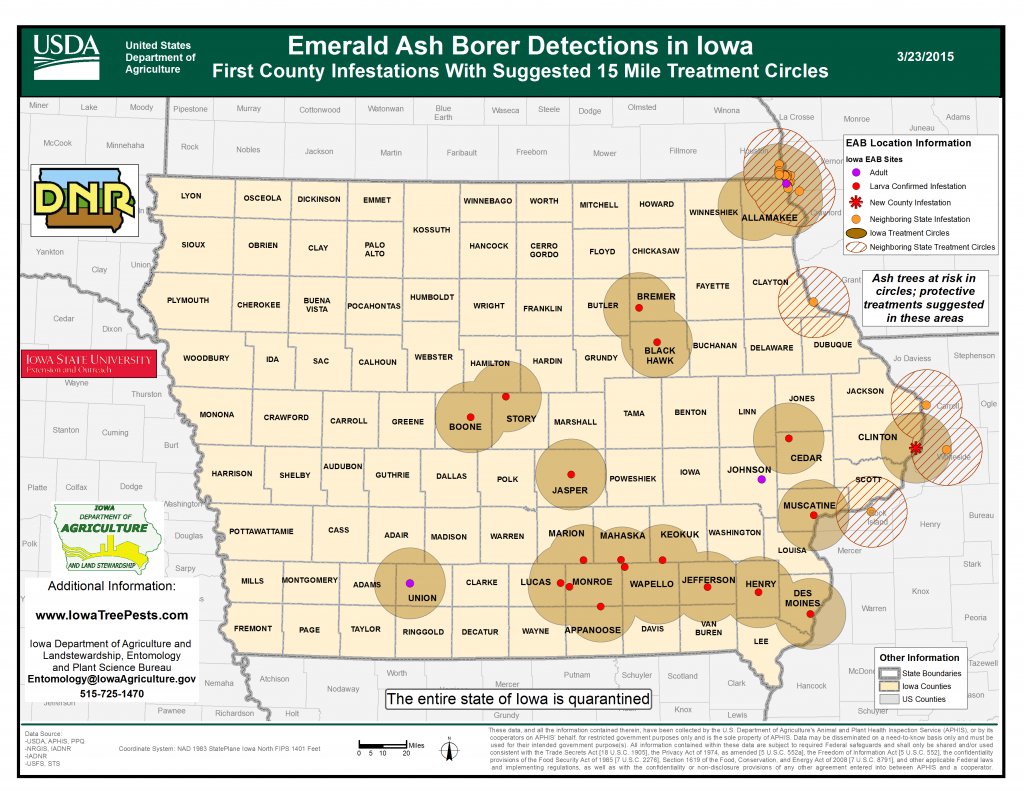For Immediate Release:
Wednesday, March 25, 2015
Contacts:
Dustin Vande Hoef, Iowa Department of Agriculture and Land Stewardship, 515-281-3375
Kevin Baskins, Iowa Department of Natural Resources, 515-725-8288
Laura Sternweis, Iowa State University Extension and Outreach, 515-294-0775
EMERALD ASH BORER CONFIRMED IN CLINTON COUNTY, IOWA
New Detection of Invasive Pest Discovered in Clinton
DES MOINES – Emerald Ash Borer (EAB) has been positively identified in the city of Clinton, making this the twentieth county in Iowa where this wood boring pest of ash trees has been found. EAB kills all ash tree species and is considered to be one of the most destructive tree pests ever seen in North America.
An ash tree with evidence of recent woodpecker activity was discovered by a member of the Iowa EAB Team. A branch was removed and bark peeled, resulting in the collection of a suspect larva that was confirmed as EAB by federal identifiers.
“Clinton unfortunately is another sizable city along the Mississippi River that has fallen victim to EAB,” said Mike Kintner, Iowa Department of Agriculture & Land Stewardships EAB and Gypsy Moth Coordinator. “This find came during the dormant part of the year when woodpecker activity is often detected. This Clinton discovery is not too far from a previous finding in Morrison, Illinois.”
Twenty Iowa counties now have confirmed EAB infestations. A statewide quarantine, issued on Feb. 4, 2014, remains in place, restricting the movement of hardwood firewood, ash logs, wood chips and ash tree nursery stock out of Iowa into non-quarantined areas of other states.
“We still strongly urge Iowans to not move firewood long distances,” said State Entomologist Robin Pruisner of the Iowa Department of Agriculture and Land Stewardship. “A large portion of Iowa is not showing signs of EAB infestation; let’s keep those areas EAB-free as long as possible be not moving wood that potentially harbors EAB or other tree pests. Be vigilant, report suspicious symptoms in counties that are not yet known to be infested to a member of the Iowa EAB Team.”
The Iowa EAB Team provides EAB diagnostic assistance to landowners and includes officials from Iowa Department of Agriculture and Land Stewardship (IDALS), Iowa State University Extension and Outreach, the Iowa Department of Natural Resources (DNR), USDA Animal Plant Health Inspection Service and the USDA Forest Service.
The Iowa EAB Team strongly cautions Iowans not to transport firewood across county or state lines, since the movement of firewood throughout Iowa or to other states poses the greatest threat to quickly spread EAB and other plant pests. Most EAB infestations in the United States have been started by people unknowingly moving infested firewood, nursery plants or sawmill logs. The adult beetle also can fly short distances, approximately 2 to 5 miles.
The next window for preventive treatment measures (trunk injection, soil injection, soil drench, or basal trunk sprays) will open mid-April to mid-May 2015. If a landowner is interested in protecting a valuable and healthy ash tree within 15 miles of a known infestation, they should use the next few weeks to have landscape and tree service companies bid on work and these bids can be reviewed before the recommended treatment time.
Please contact Iowa EAB Team members to have suspicious looking trees checked in counties not currently known to be infested. The State of Iowa will continue to track the movement of EAB on a county-by-county basis. Before a county can be officially recognized as infested, proof of a reproducing population is needed and an EAB must be collected and verified by USDA entomologists.
To learn more about EAB and other pests that are threatening Iowa’s tree population, please visit www.IowaTreePests.com. Please contact any of the following members of the Iowa EAB Team for further information:
- Robin Pruisner, IDALS State Entomologist, 515-725-1470, [email protected]
- Mike Kintner, IDALS EAB Coordinator, 515-745-2877, [email protected]
- Paul Tauke, DNR State Forester, 515-725-8450, [email protected]
- Tivon Feeley, DNR Forest Health Coordinator, 515-725-8453, [email protected]
- Jesse Randall, ISU Extension Forester, 515-294-1168, [email protected]
- Mark Shour, ISU Extension Entomologist, 515-294-5963, [email protected]
- Laura Jesse, ISU Extension Entomologist, ISU Plant and Insect Diagnostic Clinic, 515-294-0581, [email protected]
- Donald Lewis, ISU Extension Entomologist, 515-294-1101, [email protected].
- Jeff Iles, ISU Extension Horticulturist, 515-294-3718, [email protected]


